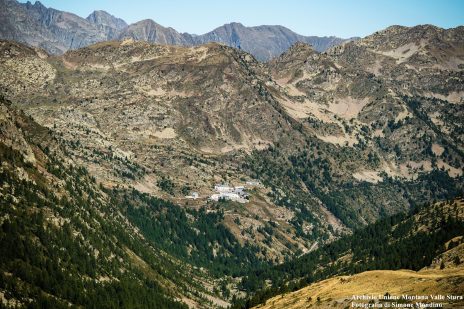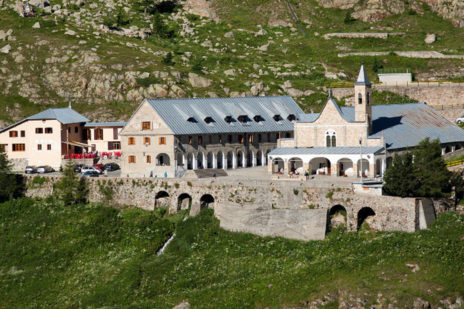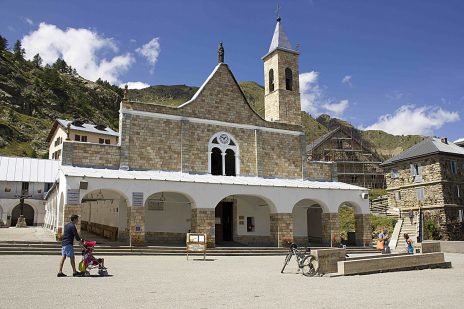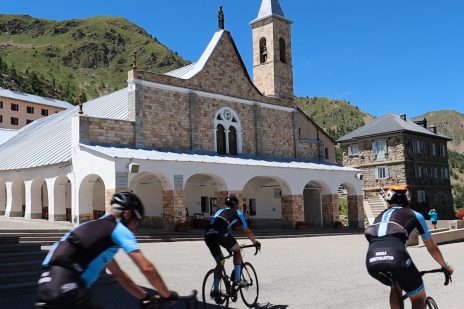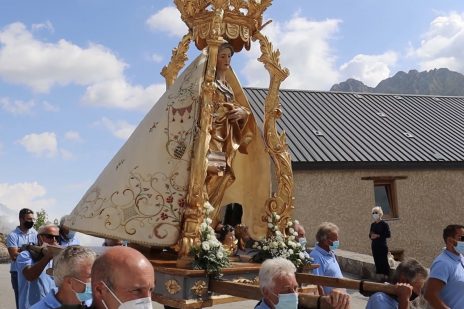In a corner of the Maritime Alps located at the head of the side valley of Orgials, in Stura Valley, in the middle of a beautiful natural high mountain environment, stands the complex of the Sanctuary of Sant’Anna, which with its 2,035 meters of height holds the record of the highest Sanctuary in Europe.
The Sanctuary is the starting point of many hikes and trekking of all kinds and difficulties. It is also located a few kilometers from the Colle della Lombarda, a cross-border pass among the most important and beaten of the provinces, which in summer allows you to reach the French Vallée della Tinèe and Nice.
Today, behind the Sanctuary, in a former military barracks, there are the Casa di San Gioachino, guesthouse with rooms and two dining rooms, in addition to the refuge/hostel San Giuseppe – stop GTA. Next to the sanctuary there is a cafeteria, always during the summer months.
The place has been a pilgrimage destination for thousands of faithful for centuries: nowadays many of them make it at night, starting from Cuneo, capital of the province of the same name, while others decide to make the final part of the pilgrimage (always at night)from the hamlet of Pratolungo, in the municipality of Vinadio. In this village there is also a stop for pilgrims, wanted and born thanks to the work of the association “The Way of Saint Anna” that since 2007 maintains the path from Pratolungo to the sanctuary and offers refreshment and rest service right in front of the hut Posto Tappa GTA.
A LITTLE OF HISTORY
The first historical document to mention a church in the Orgials valley is an act of agreement on the boundaries of Vinadio and Isola, drawn up on 23 September 1307, which names “the hospice of St. Maria di Brasca”, a small chapel with rooms for the hospitality of travelers and pilgrims. Between the eleventh and thirteenth centuries, in the vicinity of many Alpine passes, churches/hospices were built in which hermits lived whose function was to assist travelers: among these was the church of Sant’Anna.
In the fifteenth century the legend spread that Saint Anne appeared to the shepherdess Anna Bagnis on the boulder, now called “Fortress of the apparition” to indicate the place where to build a sanctuary. In 1443 appears the first document related to the church with the change of title to Saint Anne. In the meantime a new figure appears, that of the “randiere“: a guardian who resided in the Sanctuary all year round. Among his duties were to take care of the buildings, provide food and lodging to travelers and ring the bell in case of storm and fog.
In 1619 the cathedral of Apt, the first church in Europe dedicated to Saint Anne, gave the Sanctuary a small part of the relic of the Saint, which in 1722 was placed in the silver arm that is still venerated. In 1681, the new church was inaugurated with the uphill pavement. A few decades later the first block of the randiere, the stable, the barn, the attic and later new buildings to accommodate the pilgrims rise. Today, in the central nave is currently located the arm – seventeenth-century reliquary of the Saint.
From 1793 to 1796 the area was heavily militarized with the construction of numerous barracks.
In 1836, about halfway down the valley, the building known as Baraccone was erected: a shelter for travelers and pilgrims, then home to summer camps (a place where a fountain still stands, considered a fixed stop for pilgrims during the climb to the Sanctuary). In the middle of the nineteenth century the building parallel to the Church was built.
The facade and the bell tower were completed in 1881. The road was built from 1924 for military purposes, along with a cableway that connected Pratolungo to the Colle della Lombarda.
After the World Wars the buildings were renovated.
Today, the Sanctuary is open in the summer and has the moment of greatest affluence on July 26, when the feast dedicated to the Saint is celebrated.
THE PILLAR OF QUIAPERET
On the road to the Sanctuary there is an aedicule of 1917 containing a statue of Saint Anne, because from this point those who go up begin to glimpse the sanctuary. Tradition has it that every pilgrim erects a “little man” of “quiap“, pebbles, called precisely “quiaperèt“, with as many stones as there are the times he visited the Sanctuary, as a good wish for the next return.
CURIOSITA’ – The Way of Saint Anne
A new 4-day hiking/tourist trail, inspired by the existing one, was born in 2021. Discover the details at the following link!

